↑ The Solar Rays Table is for sale. See the full gallery here: TABLE GALLERY .
The Unblocked Carver
#2: The Uncarved Block: Unlock Motivation Through Self-Knowledge
Blocked:
Forget willpower. Forget motivation hacks.
Real creative power comes from knowing what drives you, not from forcing yourself through resistance.
As a woodworker, I think of a carving image: How easily a sharp carving blade slices thin shavings from a block of wood when pushed in the direction of the wood grain, and how frustrating carving against or across the grain can be.
You are like the piece of wood, and you have a nature.
Our drives are a potential source of endless motivation, but they're often blurry and contradictory instead of focused and prioritized. This leaves us at odds with nature, spending energy like a fisherman who doesn't give the fish some slack to tire itself out.
If you sit still and get to know your true nature, and you let that fish tire out, you can reel it in with ease. (the fish being a metaphor for creative ideas aligned with your drives.).
Enough with the metaphors for now. Let me get practical and tell you about a particular art piece that helped me contemplate the topic of this letter.
This is called the Solar Rays Table and it took me a year to carve:
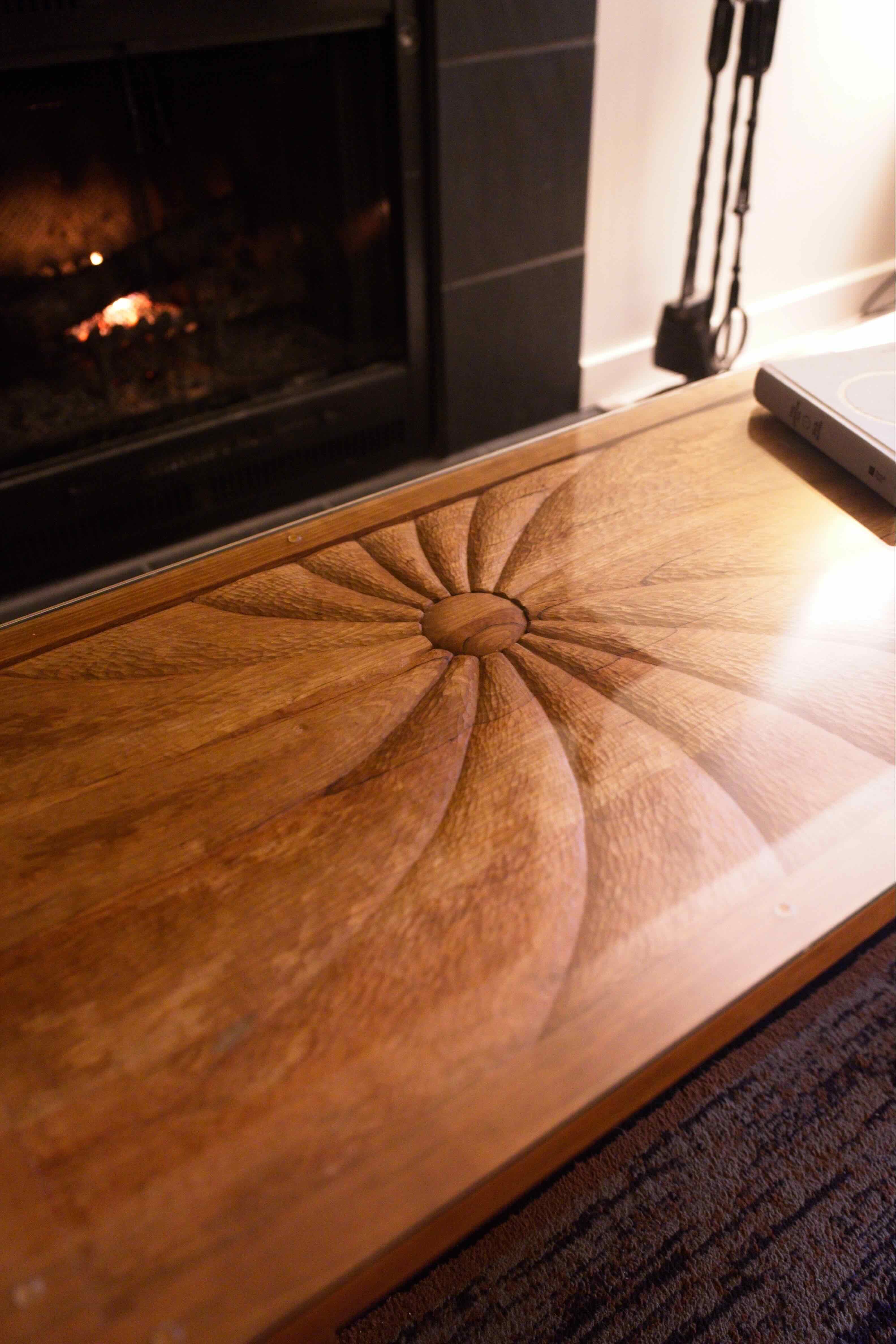
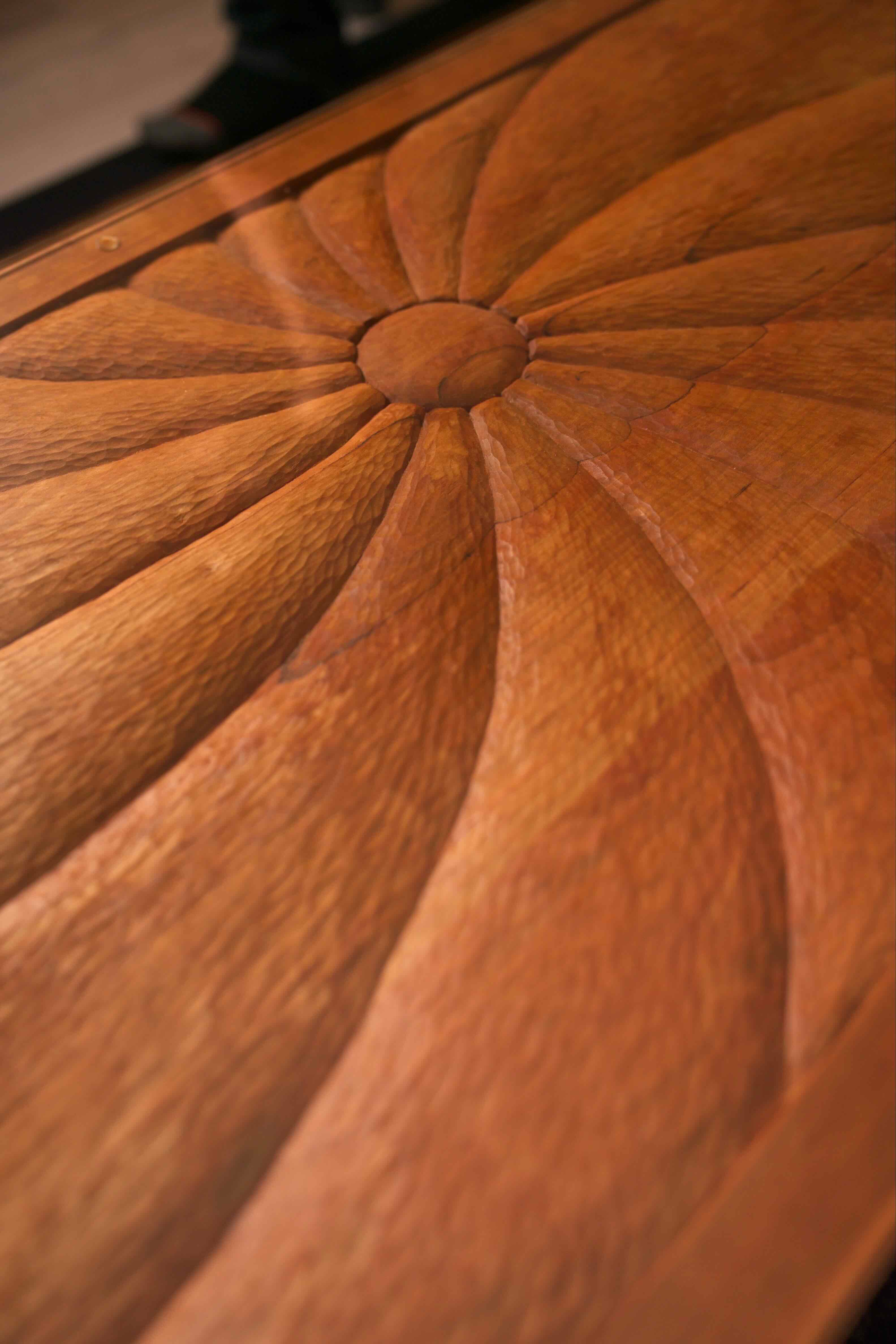
From another point of view, it took me four years. These pieces of wood followed me from home to home, and shop to shop, for four years. Somehow other projects always took precedence, and my excitement about building the table faded away.
It became clear that an ordinary coffee table wasn't exciting enough to inspire me to action.
Instead, I began plotting a design for the tabletop: a hand-carved landscape image of a Canadian moose crossing a river.
Weeks went by, and I realized I'd gone too far to the other extreme. First, I was blocked by the loss of interest in the project. Then I was literally blocked by big pieces of wood that were tricky to store in my small rented abode. Then, again, blocked by my own mind overcomplicating the situation with lofty ambition.
Finally, last year, I was living in a house with a BnB in the basement and yard inspired by Zen aesthetics. The fellow who rented the room to me had filled the house with interesting art, making it an inspiring dwelling place.
One day, fed up with these rough and sharp cornered pieces of cherry wood being in my way, I decided I'd be better off wrecking the project than lugging the pieces around forever.
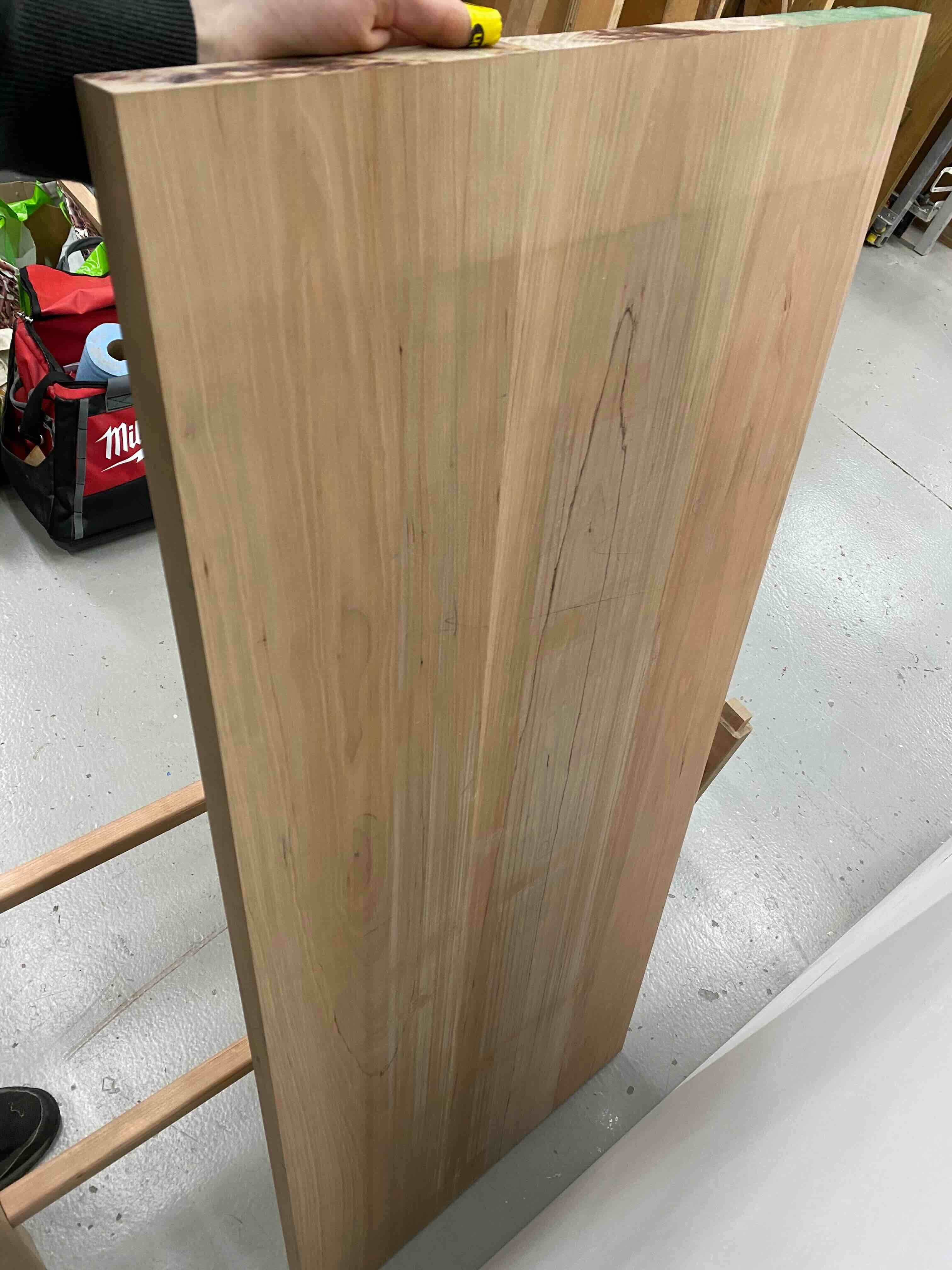
With a pencil behind my ear, I brought the tabletop out to a common area of the house to enjoy the feng-shui. Luckily for me, I was renting from a fellow whose artistic sensibilities allowed for some boundary testing.
Like an unexpected battle that demands immediate improvised counter-attack, I launched myself into action. I spontaneously drew a circle where it felt just right, and intuitively extended long curved lines from the circle to a border I'd drawn around the edge.
Clearly I was feeling joyful about the summer sunshine as this sun-ray pattern emerged.
This gave me a basic form to jump in with carving tools and start making this tabletop lighter, shaving by shaving.

There was relief in letting go of the overly complicated idea of carving such a large landscape image. I realized that my experience carving landscapes on small pieces of much softer wood was not comparable.
I didn't know it then, but carving this abstract and relatively simple design would still become one of my lengthier projects.
Sometimes I'd carry it to a nearby park and enjoy the sun scorching my neck while I carved. I found that it became an undemanding companion, hollowing my solitude.
When my energy was low, I could always still carve and enjoy the slow contemplative process, free from weighty goals.
I experienced a lot of life's ups and downs while this table anchored me in one of the few constants: my artistic drive.
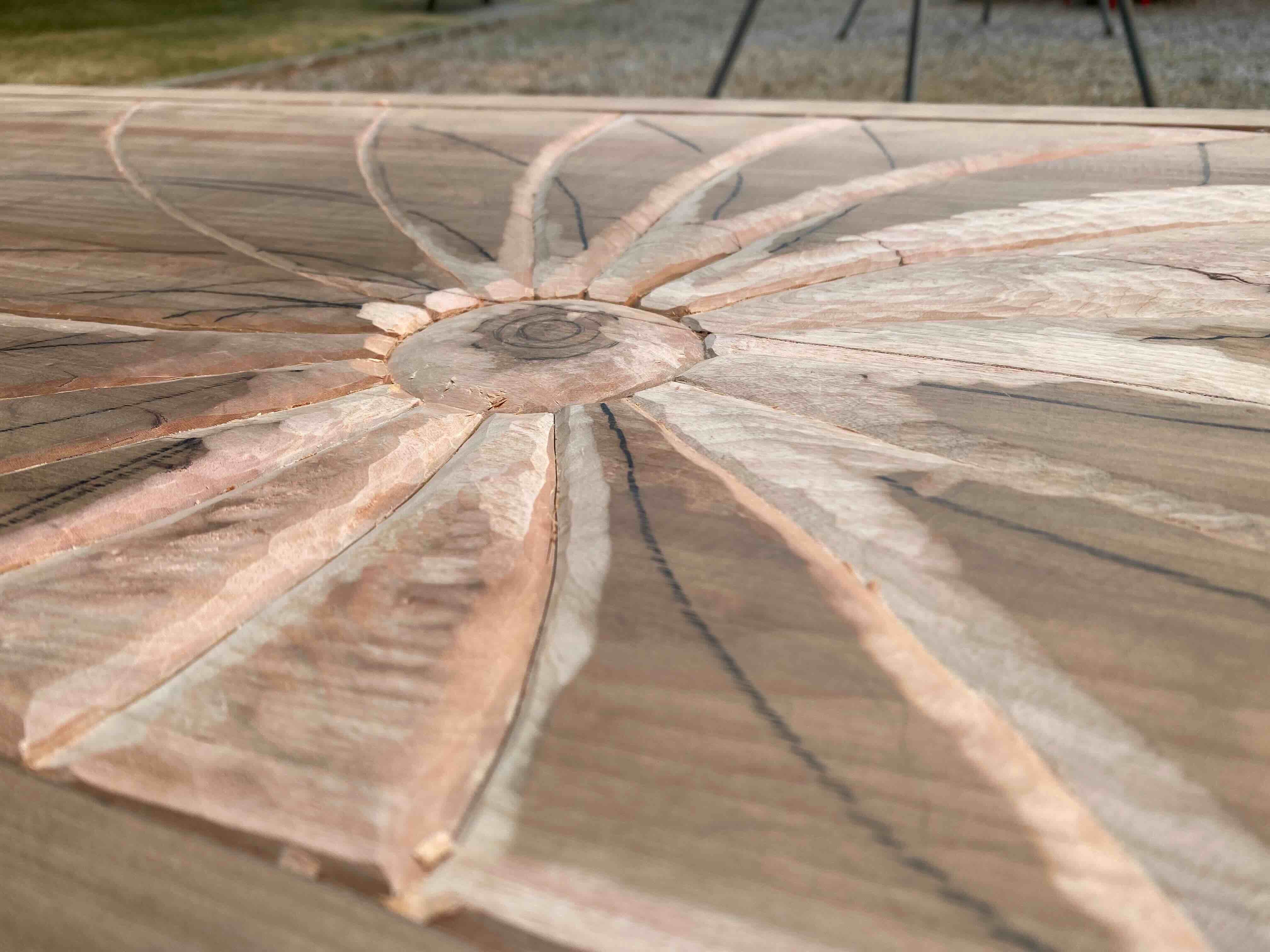
Although for a long time this chunk of cherry wood wasn't much more than a burden and a block in the path, once it truly began the piece took on its own life and inertia. No longer did I have the idea; the idea had me.
Sometimes I felt more like carving than other times, but this tabletop always invited me back and welcomed me at whatever pace, in whatever state of mind. The whole process became a meditation on the Tao.
I thought about photosynthesis.
I considered how bizarre and incredible it is that this wood is mostly composed of carbon drawn into the tree directly from the air (CO₂) and made into wood using energy captured from the sun's light.
If you set it on fire, that same energy from the sun would burst forth as the wood burns up and the carbon returns to the air, emitting photons visible as light once again.
I chiseled away a little bit at a time, only occasionally wondering how many more dozen hours remained.
A perceptual shift had taken place. I no longer saw this wood as a block in my path. Instead it became the path.
“The impediment to action advances action. What stands in the way becomes the way.” - Marcus Aurelius
To double up on my point, I'll make a confession. This newsletter was supposed to be sent out five days ago, but in my typical fashion I drastically overcomplicated it and couldn't complete it on time.
I thought: How am I going to illustrate the subtle depth of meaning of this concept from Zen tradition known as "the uncarved block"?
My thoughts spiralled into profound ideas about human perception. I read several 40+ page scientific articles on visual perception and developmental psychology, collecting quotes from them. I wrote about 2,000 words of brainstorm notes. Then I got stuck.
Blocked, you could say.
I got frustrated because I wanted to go deep on this one, but it was getting convoluted. If I kept pushing, I'd produce something that would likely be indigestible to 90% of the small readership of my brand new newsletter!
Zen, in theory, is not complicated. Yet, the "koans" or subtle tales used to explain it are often puzzling.
Alan Watts is well loved for his lectures and books on Zen, and the Tao. He once gave a talk on Zen and in his introduction said the following:
"If I addressed you in the manner of the ancient teachers of Zen, I should hit the microphone with my fan and leave."
However, since he had an audience expecting to learn something, he carried on:
"Now then if one must say something about what Zen is … I must make it emphatic that Zen in its essence is not a doctrine. There's nothing you're supposed to believe in. It's not a philosophy, a set of ideas, an intellectual net in which one tries to catch the fish of reality. Actually, the fish of reality is more like water. It always slips through the net. In water, when you get into it, you know that there's nothing to hang onto."
A clear parallel here is the first line from Taoism's core text, the Tao Te Ching, by Lao Tzu:
“Tao called Tao is not Tao.”
As incessant over-thinkers, imposing our will and trying to control the outcome is our default mode.
There are plenty of spiritual platitudes that emphasize acceptance, non-attachment, releasing control, and being "present". Zen and mindfulness have become cliché terms.
Navigating life via goals, however, is our very nature.
Perception drastically simplifies the world for the sake of goal-directed functionality. The objective world is infinitely detailed, and constantly changing. We can perceive objects thanks to this radical simplification of the world.
In his 2013 essay Three Forms of Meaning and the Management of Complexity, Dr. Jordan B. Peterson writes the following:
… “objects” are entities bounded by their affective relationship to a goal.
We perceive meaningful phenomena, not the objective world. The intuitions that guide us are pragmatic and embodied.
Not only is it necessary to have goals, but you can't forfeit them even if you try to be without ambition. "Letting go of desire," a classic misinterpretation of the Noble Truths of Buddhism, as Watts said, is like trying to bite your own teeth.
When you see a room full of objects, you know that there's incalculably more information there than what you're actually seeing. You see a landscape of affordances, as termed by JJ Gibson:
The affordances of the environment are what it offers the animal, what it provides or furnishes, either for good or ill.
(JJ Gibson, An Ecological Approach to Visual Perception)
Despite the fact that the structure of our brain and consciousness is goal derived, we've all heard the phrase "it's not the destination, it's the journey."
I agree with that 100%, but alas: life is fraught with paradox.
Author of The Art of Focus, Dan Koe, recently helped me clarify it in his newsletter in this way:
"you can argue that "the end of a melody isn't its goal," as Nietzsche would say, but the goal of the artist was to create the melody."
Perhaps there is a middle way. Indeed there is, because once I drew this abstract pattern onto the tabletop, nothing could stop me from simply enjoying the moment-by-moment process. The process of bringing the piece closer to the inner vision of its completed form was a melody to be enjoyed, but it wouldn't have existed without the inner vision of the end goal.
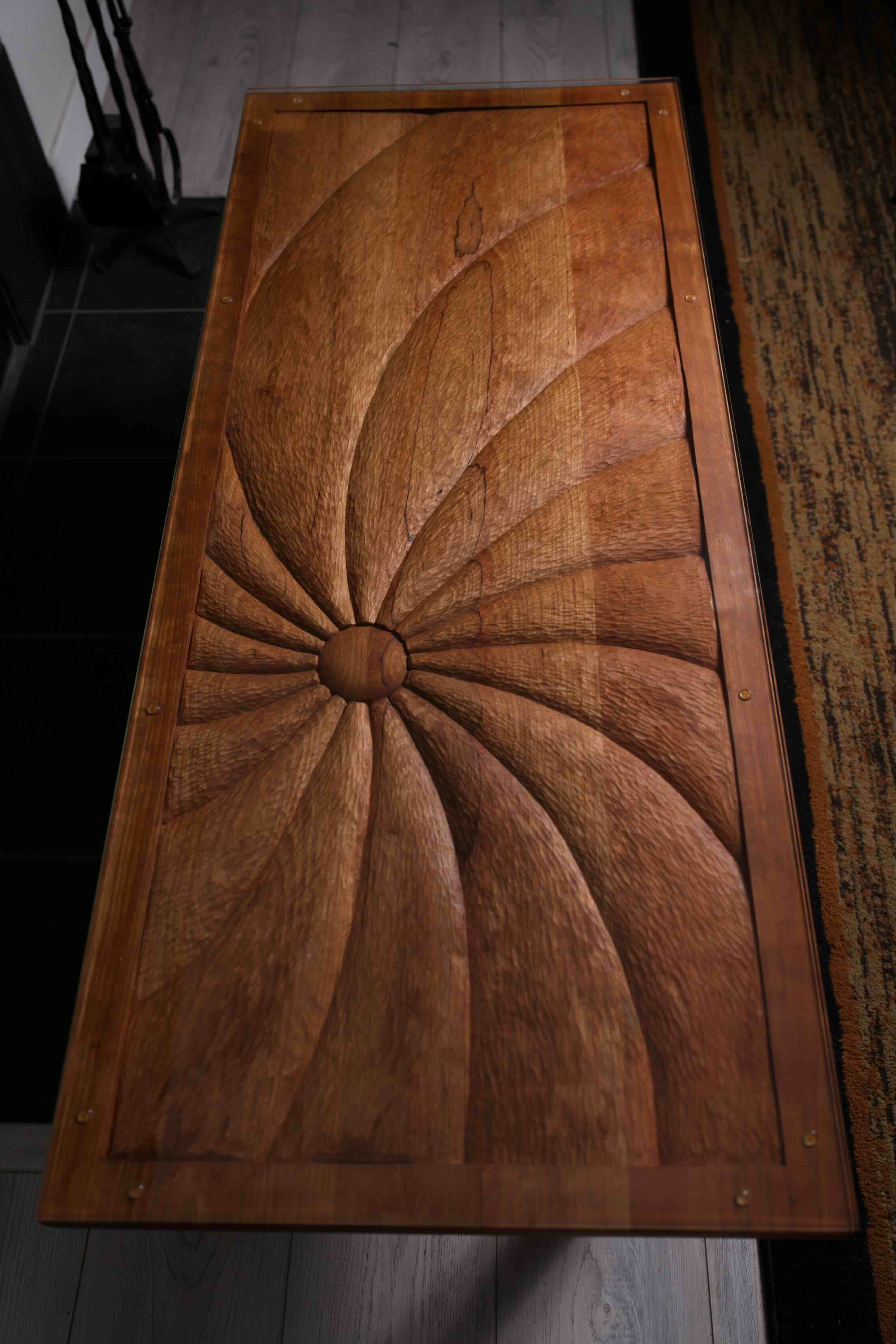
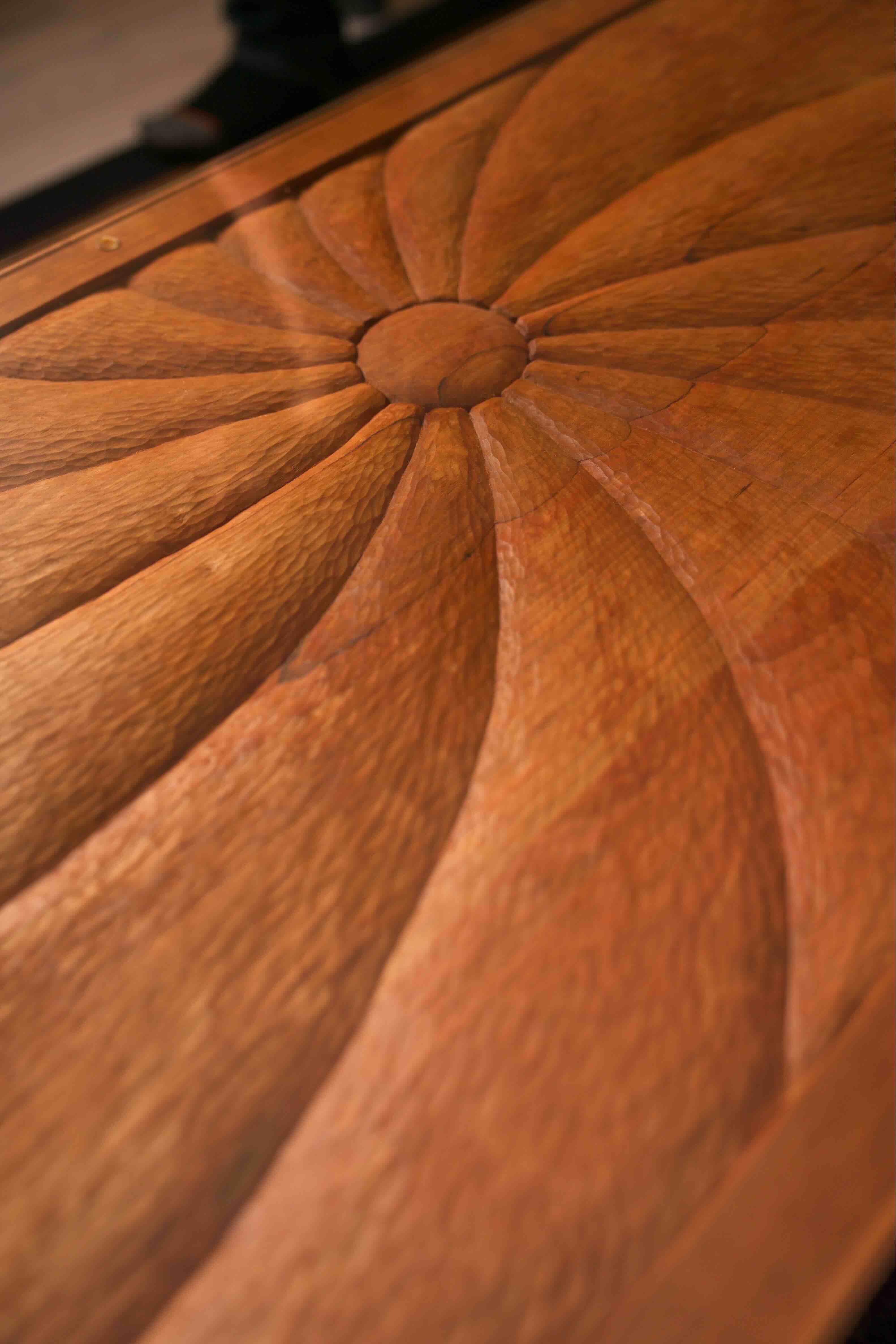
To Carve, or Not to Carve?
Oh yes. The uncarved block.
Let's refer back to a teacher whose writings I quoted in the previous newsletter. Loy Ching-Yuen's teachings were translated to English by one of my teachers, Trevor Carolan.
Ching-Yuen says this:
"This perfection of "the uncarved block" or "the unshaped, unformed, unborn" is specifically emphasized here because it is the key to all Taoist doctrine." (pg. 11, The Supreme Way)
In my story, it may appear that the uncarved block was just a nuisance! Something that just got in the way—until it was carved!
That's not the idea. That was a block in my perception.
Again I'll draw from Alan Watts who says this on the nature of how one's consciousness is meant to be transformed in Taoism and Zen:
It is not an acquisitive process of learning more and more facts or greater and greater skills, but rather an unlearning of wrong habits and opinions. As Lao-tzu said, "The scholar gains every day, but the Taoist loses every day.”
As I said at the start, you can forget about motivation. The creative power of nature is within you. It's often the intensity, direction, or lack of direction of our striving that actually blocks that power, leaving us disoriented.
The uncarved block is pure potentiality, true to nature and not stifled by rigid concepts and goals.
A good goal contains its own means of revision.
Over time, reality provides feedback, and you shuffle your hierarchy of priorities and goals around until the most functional meta-goals get to the top. Recognize that your self-centred and your unitive world-centric drives are both real parts of you. Neither can be ignored without consequence.
For someone else, the watercourse way—the natural flow—might have been to use a CNC machine to quicken the carving process. Other carvers use chainsaws without much concern for the wood's grain direction.
So forget about wood and carving with-the-grain. Remember that this was all a metaphor for knowledge of yourself.
Sitting still with yourself is part of the opportunity in creative work. It can be uncomfortable, but the alternative is to always be so distracted that you never get acquainted with the inner being who holds the key.
My hope is that in reading this letter, you come to your own useful insights that will be of value to you.
I don't want to take away from your own reflections on this piece, so please consider pausing here to remember your own thoughts.
Now, though, I will present a short collection of the insights I hoped to encapsulate as a parable in this letter:
- Motivation flows from clear understanding, not force of will.
- "Nature does not hurry, yet all is accomplished." - Lao Tzu
- Art as a contemplative practice: introspection opens the way to a vision of life that is congruent with your nature.
Thanks for giving your attention to this letter—I sincerely hope something here unlocks something for you. Your creative power offers you the discovery of deep meaning and fulfillment, and offers many treasures to those around you.
Jesse James Boyes